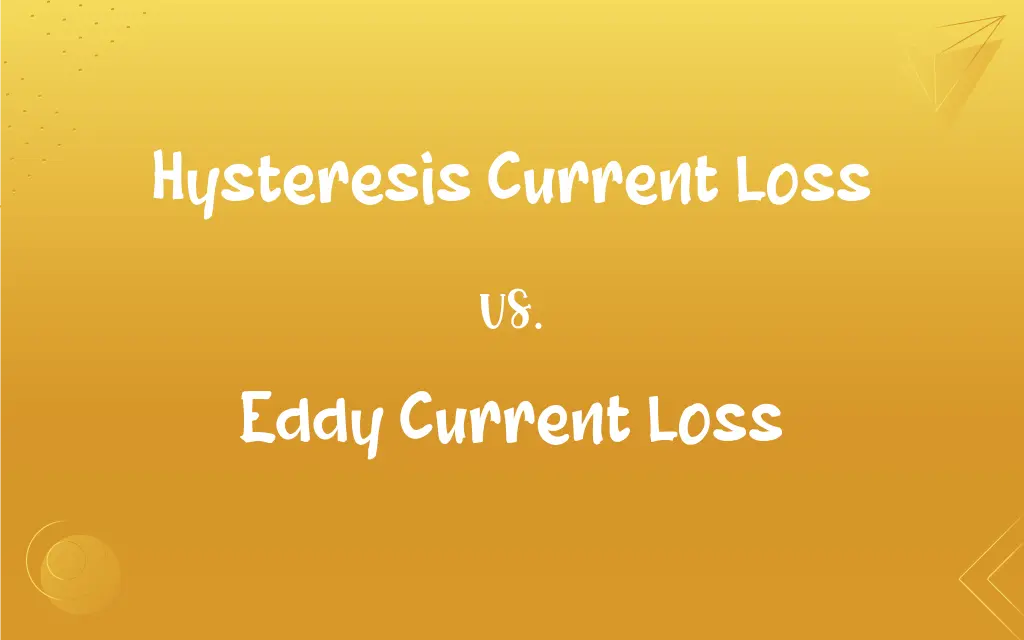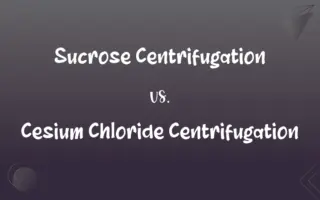Hysteresis Current Loss vs. Eddy Current Loss: What's the Difference?
Edited by Harlon Moss || By Janet White || Published on October 17, 2024
Hysteresis current loss is energy loss due to the lagging of magnetic domains in a material during magnetization cycles. Eddy current loss is energy loss caused by circulating currents induced in a conductor by a changing magnetic field.

Key Differences
Hysteresis current loss occurs in magnetic materials when their magnetic domains do not realign instantaneously with an alternating magnetic field, causing energy dissipation. Eddy current loss happens when a changing magnetic field induces swirling currents in a conductor, which dissipate energy as heat.
The extent of hysteresis loss depends on the magnetic properties of the material and the frequency of the magnetic field changes. Eddy current loss is influenced by the conductivity of the material, the strength and frequency of the magnetic field, and the physical dimensions of the conductor.
Hysteresis loss is a significant factor in materials used for magnetic cores in transformers and motors. Eddy current loss is a concern in conductors within magnetic fields, such as in transformer windings and motor rotors.
Reducing hysteresis loss involves using materials with low coercivity and high permeability. Minimizing eddy current loss can be achieved by using laminated cores, which restrict the flow of eddy currents.
Hysteresis loss remains constant for a given material and frequency but varies with the intensity of magnetization. Eddy current loss increases with the square of the frequency of the magnetic field and the electrical conductivity of the material.
ADVERTISEMENT
Comparison Chart
Cause
Lagging of magnetic domains during magnetization
Circulating currents induced by changing magnetic field
Influencing Factors
Material's magnetic properties, frequency of field
Material's conductivity, field strength, frequency, dimensions
Primary Concern in
Magnetic cores (transformers, motors)
Conductors within magnetic fields (transformer windings, motor rotors)
Reduction Methods
Using materials with low coercivity
Using laminated cores, reducing conductor thickness
Dependence on Frequency & Intensity
Constant for a given frequency, varies with magnetization intensity
Increases with frequency and material conductivity
ADVERTISEMENT
Hysteresis Current Loss and Eddy Current Loss Definitions
Hysteresis Current Loss
Remains constant for a given material and frequency.
For a constant frequency, the hysteresis current loss stayed consistent.
Eddy Current Loss
Reduced by using laminated cores in electrical machines.
Using laminated cores in the transformer effectively reduced eddy current loss.
Hysteresis Current Loss
Influenced by material's coercivity and permeability.
Selecting materials with low coercivity reduced the hysteresis current loss.
Eddy Current Loss
Dissipates energy as heat in conductive materials.
The heat generated in the transformer was due to eddy current loss.
Hysteresis Current Loss
Loss due to delayed magnetization in magnetic materials.
The transformer's efficiency was reduced due to hysteresis current loss.
Eddy Current Loss
Influenced by material's conductivity and physical dimensions.
Reducing the thickness of the conductor helped minimize eddy current loss.
Hysteresis Current Loss
Energy dissipation in magnetic materials during cyclic magnetization.
Hysteresis current loss increased with the frequency of the AC current.
Eddy Current Loss
Loss due to circulating currents in a conductor in a changing magnetic field.
Eddy current loss in the motor's rotor led to decreased efficiency.
Hysteresis Current Loss
Related to the area of the hysteresis loop in magnetic materials.
A larger hysteresis loop in the material indicates higher hysteresis current loss.
Eddy Current Loss
Increases with the square of the magnetic field's frequency.
As the frequency increased, the eddy current loss significantly rose.
FAQs
Can hysteresis loss be reduced?
Yes, by using materials with low coercivity and high permeability.
What primarily causes hysteresis current loss?
The lagging of magnetic domains in a material during magnetization.
Does hysteresis loss depend on the material's coercivity?
Yes, materials with lower coercivity have less hysteresis loss.
Does the frequency of the magnetic field affect eddy current loss?
Yes, eddy current loss increases with the square of the field's frequency.
Can hysteresis loss be eliminated entirely?
Not entirely, but it can be significantly reduced with appropriate material selection.
What is a major cause of eddy current loss?
Circulating currents induced in a conductor by a changing magnetic field.
How does frequency affect hysteresis loss?
Hysteresis loss varies with the intensity of magnetization, not directly with frequency.
Are hysteresis and eddy current losses always present together?
In magnetic applications with changing fields, both losses usually occur together.
Is eddy current loss significant in transformers?
Yes, particularly in the windings and cores.
Does hysteresis loss produce heat?
Yes, it results in heat generation due to energy dissipation.
Is hysteresis loss significant in all magnetic materials?
It varies based on the material's magnetic properties.
Can eddy current loss be beneficial?
In some applications like induction heating, it's used advantageously.
Does temperature affect hysteresis or eddy current loss?
Temperature can influence the material properties, thus affecting both types of losses.
How can eddy current loss be minimized?
By using laminated cores and reducing the thickness of conductors.
Where is hysteresis loss a concern?
In magnetic cores of transformers and motors.
How is hysteresis loss measured?
It's often measured by analyzing the area of the hysteresis loop.
What factors influence eddy current loss?
The conductor's conductivity, physical dimensions, and the magnetic field's strength and frequency.
Is eddy current loss affected by the conductor's size?
Yes, larger conductors can have higher eddy current losses.
Does the shape of the conductor affect eddy current loss?
Yes, the shape and thickness of the conductor can influence eddy current loss.
Do higher electrical conductivities increase eddy current loss?
Yes, higher conductivity can lead to increased eddy current loss.
About Author
Written by
Janet WhiteJanet White has been an esteemed writer and blogger for Difference Wiki. Holding a Master's degree in Science and Medical Journalism from the prestigious Boston University, she has consistently demonstrated her expertise and passion for her field. When she's not immersed in her work, Janet relishes her time exercising, delving into a good book, and cherishing moments with friends and family.
Edited by
Harlon MossHarlon is a seasoned quality moderator and accomplished content writer for Difference Wiki. An alumnus of the prestigious University of California, he earned his degree in Computer Science. Leveraging his academic background, Harlon brings a meticulous and informed perspective to his work, ensuring content accuracy and excellence.






































































